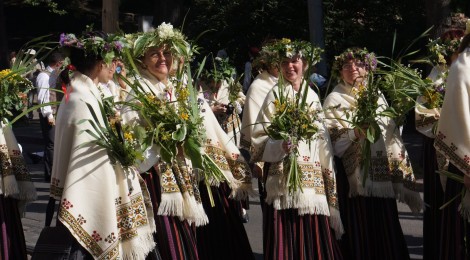
Culture
Culture
Riga will be the EU Capital of Culture in 2014 and the conference will be taking place during the nationwide celebration of Jani (Midsummer’s). Here is a link to some words and phrases that will help you get the immersion underway: http://www.latvia.travel/en/article/useful-words-and-phrases
Language
Useful Latvian Phrases
History
The area of Latvia has been settled since 9000 BC. Baltic tribes, the ancestors of present day Latvians, arrived around 3000 BC. In the 13th century after conquest of today’s Latvia, Baltic Germans settled here and gradually became the upper class and rulers of Latvia, while Latvians and Livonians lost their positions finally becoming serfs in the 16th century. This caused the Germanisation of the educated inhabitants of other nationalities, yet preserved some local traditions. In the 19th century, when serfdom was abolished, a Latvian nationalist movement, the first “Latvian National Awakening,” began. Led by “Young Latvians,” it encouraged Latvians to become artists and scholars, while preserving their cultural heritage and the language. The movement was countered by a period of Russification, followed by the leftist movement New Current at the beginning of the 20th century; it is regarded as a period in which Latvian culture thrived. This caused the second “Latvian National Awakening,” leading ultimately to the proclamation of an independendent Latvia in 1918.
On 15 May 1934, Kārlis Ulmanis seized power in a coup d’etat and established an authoritarian regime, which lasted only until the outbreak of World War II and Soviet occupation in 1939-40. In cultural terms, however, this period is seen as a “golden age” for Latvia. During the war, with a period of German occupation from 1941–45, Latvia lost its independence as it was occupied by the USSR and became the Latvian SSR. Soviet rule ended in 1991 during the third “Latvian National Awakening.” http://en.wikipedia.org
People
The majority of inhabitants are Latvians. There is a culturally and linguistically distinct subgroup, the Latgalians, who inhabit the Latgale region in eastern Latvia. Another indigenous group are the Livonians, whose Finnic Livonian language is nearly extinct. The largest minority group is the Slavic people, notably Russians. Other well known minorities are Roma people, Baltic Germans and Jews, whose population was decreased significantly during the Second World War, as well as Lithuanians and Estonians. http://en.wikipedia.org
Regions
Historical regions of Latvia, together with Latvian cultural groups. Latvia is divided into several cultural and historical regions – Vidzeme, Latgale, Courland and Zemgale. Sometimes, Sēlija and Maliena are also distinguished.
Folklore
Latvians have the rich heritage of traditional folklore, especially folk songs. Dating back well over a thousand years, more than 1.2 million texts and 30,000 melodies of folk songs have been identified.
Art
Latvian visual art has undergone various transformations over time, as the territory of Latvia has been an important trade route, and thus has often been included in the spheres of interest of other nations. Because of this, Latvian art displays the influences of many other cultures. The development of Latvian art has been closely associated with that of art in other European countries, but it has always preserved its own essential character. Latvia’s visual art has a harmonious worldview: its sculpture, painting and graphic art display a certain proportionality, a feel for stable composition and a finely nuanced range of colours, which manifests itself in the use of many earthy tones. http://www.latvia.lv/content/visual-art-latvia Contemporary art spaces include the Latvian Centre for Contemporary Art and Riga ArtSpace and the Pedvale Open-Air Art Museum.
Music
The Latvian Song and Dance Festival is an important event in Latvian culture and social life. It has been held since 1873, normally every five years. Approximately 30,000 performers altogether participate in the event.
A unique element in Latvian folklore are the hundreds of dainas or folk songs that are still sung and recited today. Lyrically, dainas concern themselves with native mythology. Stories often revolve around pre-Christian deities like the sun goddess Saule, the moon god Meness and, most notably, the life of people, especially its three most important events – birth, wedding and death (including burial).
Accompaniment to the village songs is played on various traditional instruments, the most important of which is the kokle, a type of zither related to the Finnish kantele.
Food
Latvia’s cuisine is based on natural ingredients such as wheat, fruits, cream and milk. Many dishes are seasonal or associated with calendar festivals or other events. Influenced by Poland, Russia and Germany, typical Latvian food includes pork, potatoes and cabbage. Latvians also have their own version of the East European dumpling, called ‘piragi’. http://www.mfa.gov.lv/en/latvia/about/Cuisine/food/
